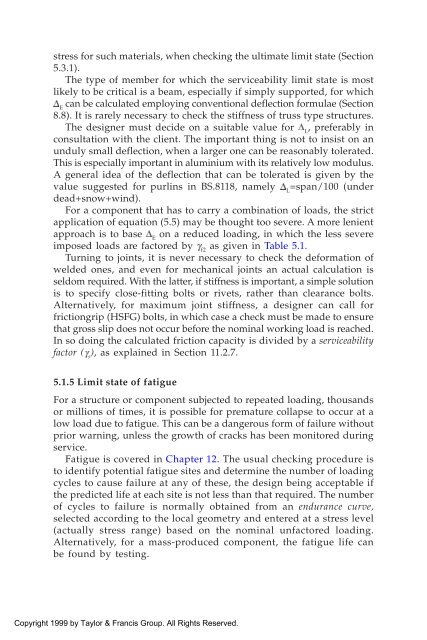Aluminium Design and Construction John Dwight
Aluminium Design and Construction John Dwight
Aluminium Design and Construction John Dwight
You also want an ePaper? Increase the reach of your titles
YUMPU automatically turns print PDFs into web optimized ePapers that Google loves.
stress for such materials, when checking the ultimate limit state (Section<br />
5.3.1).<br />
The type of member for which the serviceability limit state is most<br />
likely to be critical is a beam, especially if simply supported, for which<br />
� E can be calculated employing conventional deflection formulae (Section<br />
8.8). It is rarely necessary to check the stiffness of truss type structures.<br />
The designer must decide on a suitable value for � L , preferably in<br />
consultation with the client. The important thing is not to insist on an<br />
unduly small deflection, when a larger one can be reasonably tolerated.<br />
This is especially important in aluminium with its relatively low modulus.<br />
A general idea of the deflection that can be tolerated is given by the<br />
value suggested for purlins in BS.8118, namely � L =span/100 (under<br />
dead+snow+wind).<br />
For a component that has to carry a combination of loads, the strict<br />
application of equation (5.5) may be thought too severe. A more lenient<br />
approach is to base � E on a reduced loading, in which the less severe<br />
imposed loads are factored by � f2 as given in Table 5.1.<br />
Turning to joints, it is never necessary to check the deformation of<br />
welded ones, <strong>and</strong> even for mechanical joints an actual calculation is<br />
seldom required. With the latter, if stiffness is important, a simple solution<br />
is to specify close-fitting bolts or rivets, rather than clearance bolts.<br />
Alternatively, for maximum joint stiffness, a designer can call for<br />
frictiongrip (HSFG) bolts, in which case a check must be made to ensure<br />
that gross slip does not occur before the nominal working load is reached.<br />
In so doing the calculated friction capacity is divided by a serviceability<br />
factor (� s ), as explained in Section 11.2.7.<br />
5.1.5 Limit state of fatigue<br />
For a structure or component subjected to repeated loading, thous<strong>and</strong>s<br />
or millions of times, it is possible for premature collapse to occur at a<br />
low load due to fatigue. This can be a dangerous form of failure without<br />
prior warning, unless the growth of cracks has been monitored during<br />
service.<br />
Fatigue is covered in Chapter 12. The usual checking procedure is<br />
to identify potential fatigue sites <strong>and</strong> determine the number of loading<br />
cycles to cause failure at any of these, the design being acceptable if<br />
the predicted life at each site is not less than that required. The number<br />
of cycles to failure is normally obtained from an endurance curve,<br />
selected according to the local geometry <strong>and</strong> entered at a stress level<br />
(actually stress range) based on the nominal unfactored loading.<br />
Alternatively, for a mass-produced component, the fatigue life can<br />
be found by testing.<br />
Copyright 1999 by Taylor & Francis Group. All Rights Reserved.















